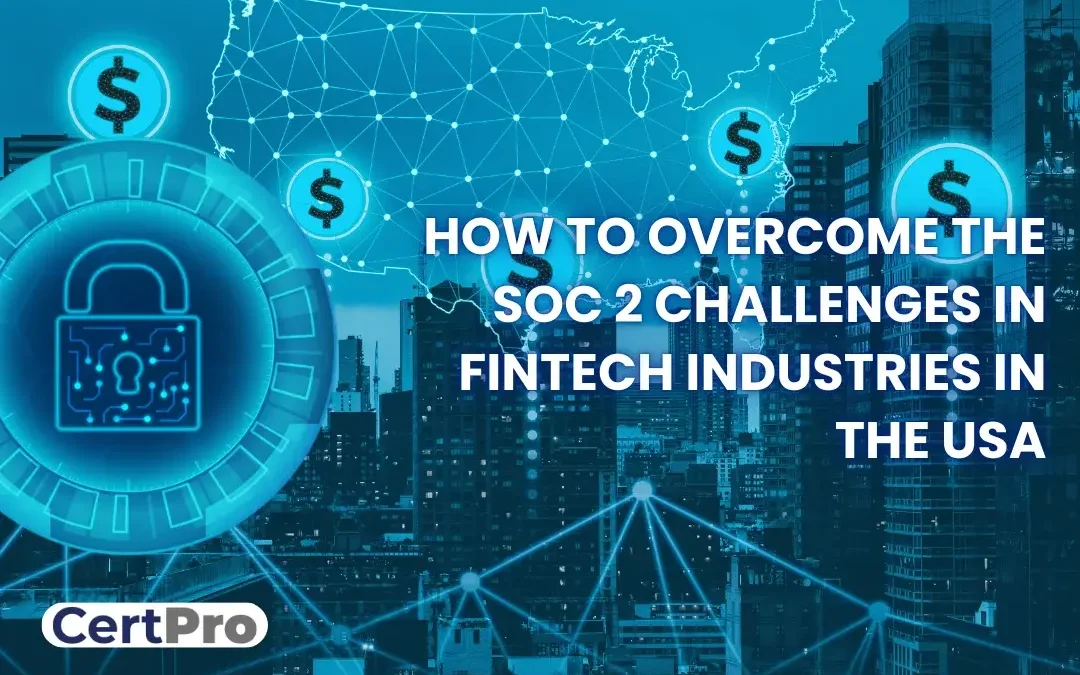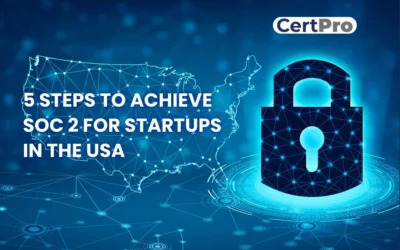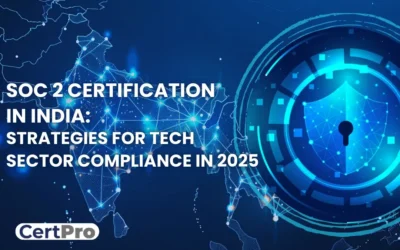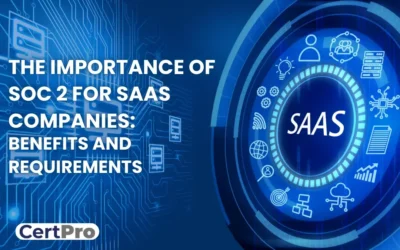Technological advancement is changing the complexity and requirements for regulatory compliance. Fintech companies are increasing their businesses in the modern era as we use technologies to accomplish our financial transactions. On the other hand, the banking and financial sectors use technologies for their daily work. Therefore, fintech industries require a standardized framework to secure their clients’ information. In this regard, SOC 2 certification in the USA can be considered a standard compliance indicator in fintech industries. SOC 2 was developed by the American Institute of Certified Public Accountants (AICPA) to audit the security and privacy of customers’ data. Nowadays, most fintech companies in the USA understand the values of SOC 2 compliance, but the implementation complexity increases SOC 2 challenges in fintech.
Furthermore, fintech companies in the USA require SOC 2 compliance audits, as financial data contain sensitive information that, when mishandled, can cause significant losses to customers and businesses. A survey by IBM suggested that fintech companies have the second-highest average cost of a data breach. In 2017, Equifax’s data breaches cost around $700 million due to their negligence on data security.
This article will discover the seven most common SOC 2 challenges in fintech companies in the USA market and try to provide some solutions. You can read the article to understand the challenges in detail, which will surely help your business.
7 COMMON SOC 2 CHALLENGES FOR THE USA FINTECH COMPANIES
Implementing SOC 2 compliance in the USA can be tricky and daunting. Even with their compact preparation, most fintech companies face challenges. So, if you are in the fintech industry and are having difficulty implementing SOC 2 compliance in your firm, then it is expected. Let’s discuss some of the common SOC 2 challenges in fintech and find out the solutions:
Challenge #1:Identification of Scope
At the initial stage, fintech companies must determine the scope of the SOC 2 audit. If your fintech company cannot select the correct scope, significant issues can arise down the line. Therefore, it will increase the SOC 2 challenges in fintech in the near future. Choosing an incorrect scope elevates unnecessary costs, extended timelines, and even failed audits. Thus, identifying scope helps recognize which system, process, and data require SOC 2 audit. For fintech industries, complex infrastructure and data cause significant challenges in selecting the SOC 2 compliance scope. Careful consideration is necessary for identifying the scope, as minor ignorance might exclude the critical systems that require audit and lead to non-compliance. However, overestimation can increase the cost of compliance.
What Can You Do?
The USA Fintech companies can map the entire IT environment and thoroughly recognize the data storage process. This consideration is required for cloud services, third-party vendors, and on-premises servers. Again, engage with the stakeholders of various departments to overlook the critical components. Your fintech company can use Trust Services Criteria (TSC) to recognize the areas relevant to the audit. Hence, you can seek support from the SOC 2 consultants in the USA to validate the selected scope before you proceed.
Challenge #2: Implementing Security Controls
One of the most common SOC 2 challenges in fintech companies in the USA is implementing security controls to meet compliance. Executing tailored controls that specifically fulfill your organization’s needs is essential. However, the process can be time-consuming for the fintech industries, especially those with massive data and processes. In addition, the challenge does not end with the implementation of controls. You must ensure the effectiveness of controls over time. In US fintech companies, the compliance team experiences difficulties in regularly maintaining and documenting the controls. Again, a lack of proper documentation can lead to non-compliance and failed audits.
What Can You Do?
You can perform a gap analysis to identify the effectiveness of controls and which controls need modification or upgradation. Compliance experts like CertPro can help you map out the existing controls against the SOC 2 compliance requirements and offer valuable suggestions. After implementing the correct controls, establish a regular audit process for your fintech. Thus, you can apply automation tools or get help for the regular monitoring process. It is essential to record all your audit findings meticulously, which will help you in the re-auditing process.
Challenge #3: Managing Third-party Risks
Fintech companies work with multiple third-party vendors for storage, customer support, and technologies. However, if these third-party vendors have access to your sensitive data, they can increase your security risks. The incident raises the SOC 2 challenges in fintech that require careful management. Thus, fintech companies need to collaborate with third parties that have SOC 2 compliance. Nevertheless, the task can be daunting and challenging to achieve. A robust third-risk management strategy can help you assess the security practices of your vendors. Thus, the process will ensure that the vendors follow the strict security compliance protocol and reduce the risk of data breaches. If you fail to access your vendor’s risk, then it might threaten your security posture and ultimately lead to non-compliance-related penalties.
What Can You Do?
A thorough risk assessment for third parties is essential to reducing the SOC 2 challenges in fintech. Focus on those who have access to your data and systems. Before collaborating with them, ask for SOC 2 reports and other security protocol details. Again, if one of your vendors does not have the SOC 2 report, perform the audit to continue the collaboration.
Challenge #4: Continuous Compliance Monitoring
SOC 2 Compliance in the USA requires ongoing maintenance. Many fintech companies need help maintaining SOC 2 compliance after getting the final audit report. Thus, a lack of proper monitoring and updates leads to a fallout of compliance. The incident elevated the risk of security breaches in fintech companies. Addressing these SOC 2 challenges in fintech requires keeping your controls up-to-date and staying informed about the latest trends in cybersecurity and the SOC 2 framework.
What Can You Do?
In this regard, your fintech company must establish a culture of continuous monitoring processes. Thus, you can incorporate employee training sessions and awareness programs. This ensures your employees are well-versed in SOC 2 compliance practices. Further, you can use automated processes to recognize gaps in the process or challenges in the controls. This helps you take prompt action at the initial level. In addition, automation of the compliance process regularly reviews the controls and allows you to align with evolving regulatory compliance.
Challenge #5: Collecting the Evidence
Evidence collection is one of the critical processes of a SOC 2 compliance audit. It multiplies the SOC 2 challenges in fintech companies. During the external audit process, auditors will review the documentation of policies, procedures, and logs. The review will ensure that your implemented controls are performing effectively. From a fintech point of view, collecting evidence in detail can be a nightmare as the process is complicated and vast. Thus, inconsistent and outdated documentation can lead to unsuccessful audits in fintech companies.
What Can You Do?
You can hire an auditor or compliance expert to document all the evidence to avoid such a mess. In this regard, CertPro can help you to organize your evidence and streamline the audit process. On the other hand, you can get help from automated tools that will store, categorize, and regularly update your documents. Hence, you must ensure that the evidence is reviewed and updated periodically to address the SOC 2 challenge in fintech for the US market.
Challenge #6: Managing Resource Constraints
Maintaining SOC 2 compliance requires an intensive workforce for auditing, evidence collection, and monitoring process. Maintaining such infrastructure is difficult in fintech industries. It requires additional resources, effort, and time, which are difficult to manage. Remember that your businesses and operations should not stop for your audit process. In fintech, priorities should be given to the client’s commitments and simple banking processes. Also, your compliance practice should not affect it. However, your compliance practice is also necessary to comply with the industry-specific regulations.
What Can You Do?
To eliminate the SOC 2 challenges in fintech, you can seek support from cybersecurity experts or automate the compliance process. This will reduce the manual workload and make compliance simple and straightforward. Hence, cybersecurity experts in the USA can help you with the internal and external audit process and identify gaps in the process to continue the compliance journey.
Challenge #7: Adapting to Changes in SOC 2
SOC 2 compliance is a journey, not a destination, for your fintech. However, the SOC 2 report signifies your achievement towards data security that requires continuous auditing and upgradation. The SOC 2 framework changes over time to keep up with new security risks and changes in technology that can create SOC 2 challenges in fintech. Hence, fintech needs to keep up with these changes to stay aligned, which can be hard to follow.
What Can You Do?
You can develop a way to keep up with changes to SOC 2 compliance. To stay compliant, follow the newsletters from related industries, attain webinars, and get regular help from SOC 2 experts. Thus, your effort will keep your SOC 2 report up to date; your fintech company will be under a constant audit process.
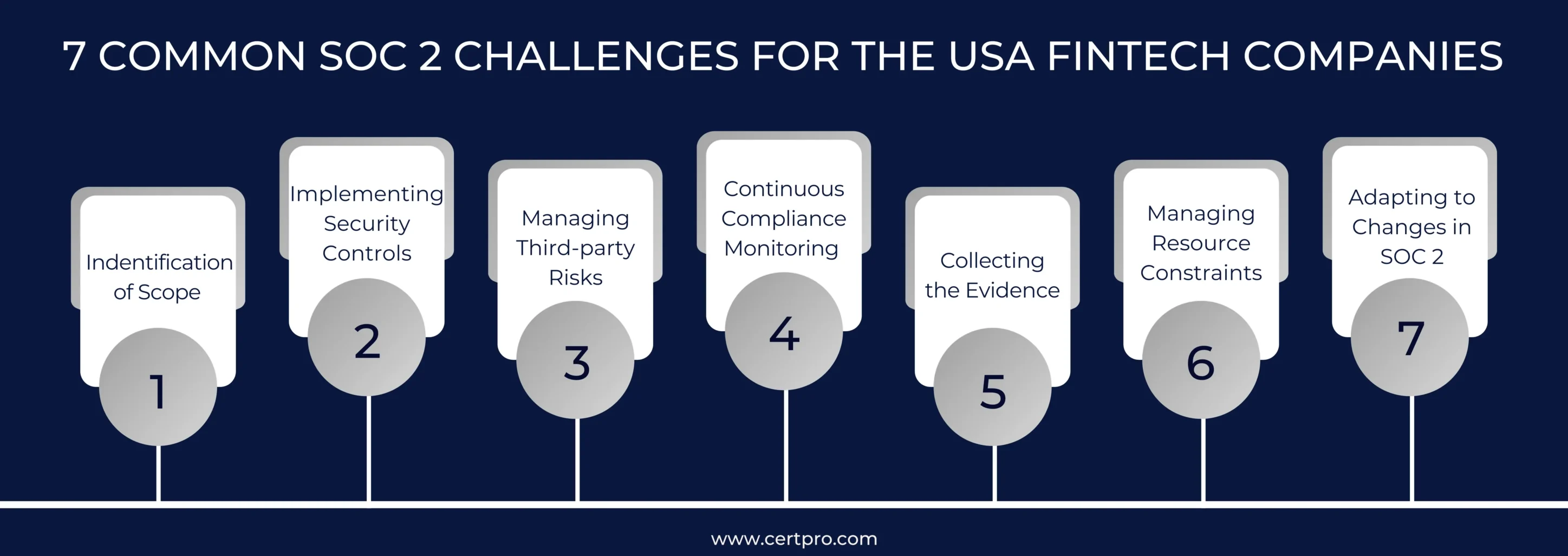
CERTPRO’S GUIDANCE FOR SOC 2 CHALLENGES IN FINTECH Companies in the usa
In Fintech, which is very competitive and changes quickly, getting a SOC 2 report is helpful for more than just following the rules. It is a smart investment that strengthens security and makes processes run smoothly. However, the process causes SOC 2 challenges in fintech that can be eliminated with proper planning. In addition, SOC 2 compliance in the USA is becoming essential for businesses shaping the future of finance. This makes them more trustworthy and safe in the digital financial ecosystem.
The path to compliance can be challenging. However, you can get expert guidance on your compliance journey. CertPro can help you in this regard and assist you in building a strong security posture that earns the trust of your customers. Thus, remember that SOC 2 compliance is not just about passing an audit. It is making your company safe and trustworthy. Business collaboration with CertPro can reduce SOC 2 challenges in fintech and make you a reliable partner in your cybersecurity journey.
FAQ
How does SOC 2 compliance benefit fintech companies?
SOC 2 compliance ensures that fintech businesses have the tools that keep customer data safe. It is important because it shows that your company cares about security, which builds trust with users and lowers the risks of data breaches in financial sectors.
How do we determine the scope of the SOC 2 audit for fintech?
You need to list your fintech’s data, tools, and processes. Start understanding your firm’s IT environment and consulting with key stakeholders. Use the Trust Services Criteria (TSC) to help you decide the scope.
What are the best practices for managing third-party risks in fintech?
Carefully evaluate vendors’ risk, review their SOC 2 reports or similar certifications, and include compliance terms in contracts. Check and update these ratings regularly to ensure data security.
What are the main SOC 2 compliance challenges in U.S. fintech?
Staying aligned with SOC 2 requires constant monitoring, regular updates to controls, and knowledge of changes to the framework. This includes keeping up with changes and avoiding slip-ups that could lead to non-compliance.
What’s the best way for fintech companies to keep up with SOC 2 changes in U.S?
Regularly follow industry updates, attend webinars, and consult SOC 2 experts. Staying informed on SOC 2 changes helps fintechs adapt quickly and maintain compliance.

About the Author
RAGHURAM S
Raghuram S, Regional Manager in the United Kingdom, is a technical consulting expert with a focus on compliance and auditing. His profound understanding of technical landscapes contributes to innovative solutions that meet international standards.
5 STEPS TO ACHIEVE SOC 2 FOR STARTUPS IN THE USA
SOC 2 for startups is gradually gaining popularity due to increasing incidents of data breaches. Previously, security was considered an afterthought for startups, while growth was the prime concern. Hence, startups focus on generating revenues instead of taking...
SOC 2 CERTIFICATION IN INDIA: STRATEGIES FOR TECH SECTOR COMPLIANCE IN 2025
The AICPA developed SOC 2 certification in India as a collection of guidelines to assist IT businesses in protecting client data. With the rapid growth of India's digital sector, safeguarding personal data is more crucial than ever. Businesses must demonstrate their...
THE IMPORTANCE OF SOC 2 FOR SAAS COMPANIES: BENEFITS AND REQUIREMENTS
SOC 2 is a data security standard developed by the American Institute of Certified Public Accountants (AICPA). The standard offers the desired level of privacy and security regarding customer information. The rule is not mandatory, but it has multiple benefits for...

